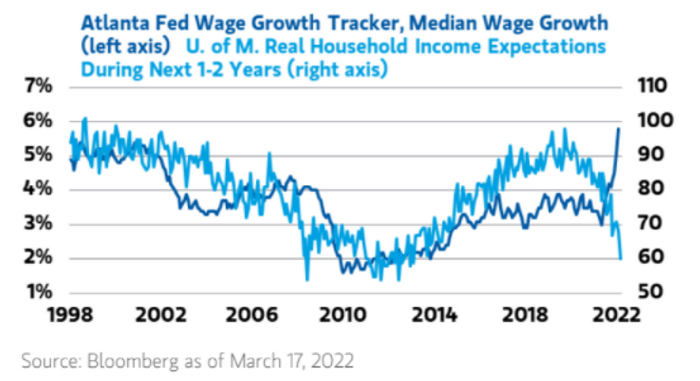Investors should “resist chasing reflexive rallies” in the stock market as it’s uncertain whether the Federal Reserve will be able to engineer a soft landing for the economy while fighting hot inflation, according to Morgan Stanley Wealth Management.
“Banking on an economic soft landing, and thus a bullish outlook on stocks, may be premature,” said Lisa Shalett, chief investment officer of Morgan Stanley Wealth Management, in a note Monday. “The big question: Will consumers keep spending if their views of real income don’t improve soon?”
While annualized wage growth has risen close to 6% amid a tight labor market, “household estimates of their real incomes are cratering,” according to Shalett.
Read: Can a bag of groceries sink stocks? Wall Street weighs in as the Fed tightens financial conditions
How consumers choose to spend will have “profound implications for both growth and inflation,” she said. The potential for “a revival in services consumption” plus a decline in goods demand may lead to “negative earnings surprises” for companies as they rebuild their inventories in the pandemic, according to her note.

Last week the Fed lifted its benchmark interest rate by 25 basis points, from near zero, and signaled its intentions for another six hikes this year to tame high inflation. Additional hikes would bring the rate to 2.8% in 2023, according to the median projection of Fed officials.
While “markets initially welcomed the Fed’s resolve to fight inflation,” Shalett saw the central bank’s “admission that inflation and world events are likely headwinds to growth” as more concerning. Fed officials cut their forecast for U.S. economic growth this year to 2.8%, from “a robust” 4%, she wrote.
“Paradoxically, the stock market rallied, ignoring the downgrade in the growth outlook,” said Shalett. “Investors need to lower expectations and resist chasing reflexive rallies.”
Meanwhile, the bond market sees “increased chances for a policy mistake” by the Fed, she said, pointing to the flattening of the U.S. Treasury yield curve. “There is little debate even among Fed governors that the central bank is ‘behind the curve’ in fighting inflation,” Shalett wrote.
All three major U.S. stock benchmarks closed lower Monday after Fed Chair Jerome Powell said in remarks to the National Association for Business Economics that “inflation is much too high” and opened the door to hiking rates by more than 25 basis points, if needed. The Dow Jones Industrial Average DJIA, -0.58% ended 0.6% lower, while the S&P 500 SPX, -0.04% slipped less than 0.1% and the Nasdaq Composite COMP, -0.40% fell 0.4%, according to FactSet data.
In his speech Monday, Powell also noted that history shows it’s possible for the economy to achieve “a soft landing” as the Fed tightens its monetary policy. He said the central bank raised the federal funds rate “significantly” in 1965, 1984 and 1994 without precipitating a recession.
Investors have been watching the yield curve for inversion as that historically has preceded a recession. The yield curve spread between 2-year and 10-year Treasurys traded around 18 basis points on Monday, flattening from about 0.30 basis points on March 15, the day before the Fed announced its first rate hike since 2018, according to data from the Federal Reserve Bank of St. Louis.
The yield on the 10-year Treasury note TMUBMUSD10Y, 2.294% rose to 2.315% Monday, a 52-week high, while the yield on the 2-year Treasury note TMUBMUSD02Y, 2.123% climbed to a 52-week high of 2.132%, according to Dow Jones Market Data.
Investors should consider adding U.S. Treasurys and investment-grade credit “to hedge stock market volatility,” according to Shalett’s note.
“We believe that US Treasury yields are closing in on theoretical cycle peaks and that value is beginning to be restored,” she wrote. “As the yield curve flattens, upside for long-duration rates may be more contained as policy actions offset any moves higher in inflationary expectations.”
The core inflation rate, excluding food and energy, was running at 6.4% over the 12 months through February based on the consumer-price index, according to data released by the U.S. Bureau of Labor Statistics. That “scorching” rate of inflation came as “the fed funds rate was 0%, a policy gap last observed in 1974,” said Shalett.
Including food and energy, the consumer-price index rose in February to 7.9% on a 12-month basis, the highest level since January 1982.
“We are skeptical that rate hikes alone will be enough” to fight inflation, Shalett said. But “the potentially more important part of the required policy mix—balance sheet reduction and liquidity withdrawal—is still to be determined and its impact on markets and the economy still unclear.”
Read: What happens to money when the Fed starts shrinking its balance sheet?
The Fed’s plans to shrink its balance sheet under so-called “quantitative tightening” that’s expected to be announced in May, according to Shalett. Morgan Stanley’s U.S. economists assume quantitative tightening will begin mid-2022 at $80 billion per month, with about $500 billion in balance sheet reduction through year-end.
“In tightening terms, that’s the equivalent of another 25-basis-point hike,” according to Shalett’s note. “In contrast, balance sheet run-off totaled $700 billion from 2017 through 2019 before the Fed stopped because markets seized and stocks sold off.”
The uncertainty around how much “liquidity withdrawal” the market and economy can stand before “it starts to pinch” adds risk that “should be compensated” through lower price-to-earnings multiples in the stock market, according to her note.
“With their credibility on the line, the Fed has turned hawkish at a particularly fraught time for the global economy,” said Shalett. “Recent aggressive guidance around rate hikes and a clear concern around inflation suggest rising chances of a policy mistake as the central bank is forced to tighten into global slowing conditions.”








